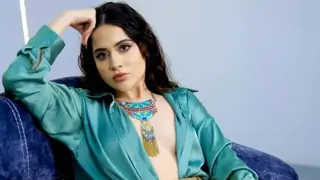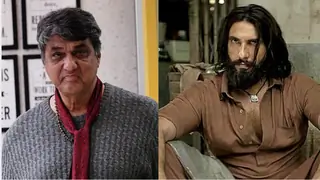The Real McCoys, the Power-Puff Girls, the Funny Boys, the News Hounds, the Style Meisters and the Loony Tooners make TV rock.
The Real McCoys
You know them by: They were the guys-next-door. And overnight they transformed from amateur singers to rock stars. You root for them, send a million SMSs and after a complete makeover, they become your heroes. It only takes 15 minutes of fame to inspire millions like them.
Usual suspects: Abhijit Sawant, our first 'Indian Idol', Qazi Touqueer ('Fame Gurukul'), who shot to fame because of his resemblance to Hrithik Roshan, Himani Kapoor, a runner-up at 'Zee Sa Re Ga Ma Pa Challenge 2005' has bagged many projects and Ruprekha Banerjee of 'Fame Gurukul' among others.
Most likely to say: Debojit Saha (winner of the 'Zee Sa Re Ga Ma Pa Challenge 2005') says, "I have a responsibility towards all my fans and I have to live up to their expectations." Ruprekha, who wants to concentrate on playback singing, adds, "Reality shows have helped us jump the line. Our struggle is over. We just have to make good use of the opportunity given to us."
Tribal future: Sums up Anupama Mandloi, senior vice president and head of programming, Sony Entertainment Television, "While soaps and serials will continue to be part of the daily diet, reality shows will continue to bring in freshness and allow for experimentation. It will also help redefine viewers' perceptions of entertainment and build their expectations towards sampling and enjoying the 'dessert diet'." -Nuzhat Aziz
KNOW MORE
- After winning his title, when Debojit Saha (of 'Zee Sa Re Ga…') returned to his hometown in Assam, there were people waiting for him at the airport from the night before. It took him eight hours to reach home, instead of the usual 45 minutes. Qazi Touqueer is gearing up for a Bollywood film that will see him in a superhero avatar.
- Sandeep Acharya (winner of 'Indian Idol 2') has bagged a project with composers Sandeep Chowta and Anu Malik for a film.
SPEAK UP
- "I've been an avid follower of all the reality shows and I aspire to be like the winners some day. I think it's a great way to be a star overnight." —Yadhis Amin, BPO employee "I adore Debojit Saha ('Zee Sa Re Ga Ma Pa Challenge 2005'). I think he rocks! He should be in the movies." —Nikita Aviet, BPO employee
- "I think reality shows in India still lack the packaging of shows abroad. Here they focus more on emotions and drama — it's as if you are watching soaps."—Varun, student
The Power-Puff Girls
You know them by: They rule your lives and dominate your living rooms every single evening. They've managed to break the glass ceiling and emerge in different avatars. A liberal touch of the sindoor (bahu), loud make-up with the latest netted sari (vamp) and a twist in the track (creative head) is how you differentiate one from the other. They are the new brand of woman-power that's rocking your TV screen.
Usual suspects: Smriti Z Iraani (Tulsi) who became a cult icon and was declared the face of the Indian bahu. Plus, not to forget the arched eyebrows and negative vibes of Urvashi Dholakia (Komolika) who became the symbol of the small screen vamp.
Most likely to say: As Rakshanda Khan (Roshni in 'Kasamh Se') says, "In television, the hero is actually the woman. Her character has evolved over the years. She has been a part of kitchen politics, managed to crack a deal at the work place and without batting an eyelid, has even put vamps in their place." Shubhaavi K who plays Meera in 'Kyunkii…' adds, "There has to be black for white to stand out. That's the reason why a negative character is required in soaps. I'm glad I've been given an opportunity to portray a negative character."
Tribal future: Producer Shrishti Arya ( 'Twinkle Beauty Parlour') predicts that women will continue to rule the airwaves in the near future. "There has been a change in programming and TV is a lucrative career option. In the days to come, with the introduction of DTH (direct to home), the demographics of viewership will become clearer. This will help to enhance variety in programming and there will be several options to choose from. But family dramas will continue to be popular." -Nuzhat Aziz
KNOW MORE
- Shubhaavi K's first salary was Rs1,500. Today, she earns approximately Rs25,000 per shoot.
SPEAK UP
- "I never miss soaps and my favourite character is Bani in 'Kasamh Se'. In fact, our dinner time is post 11 pm." —Kavita Desai, house wife
- "I watch soaps because of my wife. But the saas-bahu sagas are a refreshing change from the mundane life." —Milind Bagwe, businessman
"I love the fact that the focus in all the serials is on women. Finally, we can see that women can be successful everywhere." —Elisha, student
The Funny Boys
You know them by: Laughter is the best medicine and these guys know it best. They breathe life into the idiot box and are a necessary respite from the saas-bahus.
Usual suspects: While 'The Great Indian Laughter Challenge' winner Sunil Pal stands for the success of reality shows, VJ Cyrus Sahukar has redefined the term goofy-spoofy. Shekhar Suman's 'Movers & Shakers' has left an indelible mark on Indian TV, just like the laugh-riot 'Johny Ala Re'.
Most likely to say: "I have been doing stand-up comedy for the last decade. And I have realised that whether it's drama, thriller or comedy, TV is the writer's medium just as films are a director's and stage an artiste's. TV has made me who I am!" says Sunil. Gaurav Gera (Dhoklabhai in 'Ishq Ki Ghanti') says, "Comedy is probably the most difficult genre. The show has the right blend of subtle yet double-meaning and mature humour." To that, Semi Girebal (aka VJ Cyrus) pitches in, "After all, people look their best when they laugh."
Tribal future: Cyrus feels that there should be greater audience interaction. "We should do away with laughter tracks and get live audiences," he states. Johny Lever stresses on the need to be different. "I don't see why we have to look up to Hollywood. India has a rich culture that we comedians can and should draw from," he states. -Vidya Prabhu
KNOW MORE
- Cyrus Sahukar wore his "ugly digital watch" every time he played Semi Girebal. He feels it's the only thing that helped him remember who he was!
- Impressing girls was always high on Gaurav Gera's list. He would go to any extent to attract their attention. So much so that he would steal items like earrings from shops and later gift them to the girls in school!
SPEAK UP
- "I love 'Johny Ala Re'. Johny Lever is simply hilarious and has a great sense of comic timing. His Keshto Mukherji act reminds me of the yesteryears. I think it's a great show that makes me laugh non stop." —Mala Khan, homemaker "I would definitely watch a comedy. The so-called saas-bahu sagas are all about beating around the bush. They keep prolonging the story for generations. Comedy on the other hand helps me unwind." —Jyotsna Frankson, bank employee
- "What better comedy than the saas-bahu serials? On one day, they'll be 40-years-old and on the very next day, they'll be 80!" —Aakriti Bhatia, college student
The News Hounds
You know them by: They'll hardly ever answer their phones (unless it's midnight) and they're always in a tearing hurry. And, of course, you can't miss them on television every time you switch to a news channel. They're the face of news, day in and day out.
Usual suspects: NDTV's Sreenivasan Jain, CNBC's Udayan Mukherjee and Times Now's Arnab Goswami and Mini Menon who give you news from Mumbai by the hour, on the hour.
Most likely to say: "Being able to connect is the one thing that will always differentiate a top-class anchor from any other," says Udayan, adding that depth, composure and expertise work well too. On the other hand, Sreenivasan says there isn't a typical formula to be a good anchor but agrees with Udayan saying, "Unless one presents news from a journalist's point of view and not just the stereotypical anchor, nothing really make an impact."
Tribal future: With more news channels available for a viewer than ever before, presenting news is just as important as the content. "The team I have here is so terrifically driven and committed to the first principles of journalism that it makes an old cynic like me less cynical," says Sreenivasan. He says as the shortage of experienced journalists who understand television is slowly being met, TV news will now see "cutting-edge coverage that has as much depth as it does accuracy and speed."
—Sandhya Menon
KNOW MORE
- Sreenivasan Jain, a self-confessed music fiend, would have been a groupie if he hadn't taken up journalism. "I would have loved to tour with bands and write about them."
- Udayan Mukherjee, contrary to his businesslike image, is a complete epicurean. He loves the fine things in life - food, art (Souza, Gaitonde, Jamini Roy), music (jazz), wine, single malts.
SPEAK UP
- "The only reason for me to watch a particular news channel is the seriousness with which the person is anchoring the news." —Shailesh Ravi, business development manager "Women make better anchors as long as they know what they are talking about. They seem to be more pleasant and not to mention, better looking."
- "I think all news channels look the same, mispronounce the words similarly and dramatise every issue. If you have seen one you've seen them all!" —Priya M Menon, journalist
—Rajiv Nair, acccount executive
The Style Meisters
You know them by: They know what's in and what's not — what sells, what's hot, and what's fabulous! No, they aren't models or fashion designers; they are the new brigade of anchors, scriptwriters, producers and promoters of lifestyle and trend-based shows on television.
Usual suspects: Clad in Fabindia shirts and Manolo Blahnik shoes, they smile their way into homes, wardrobes and lives of the rich and the stylish. Meet Bandana Tewari of 'Simply Style', Zubin Sarkari of 'Trendzsetters', model Nina Manuel who hosts 'After Hours' and Lubna Adam, the creative director of Zee Trendz and Zee Caf.
Most likely to say: "The emerging programming trend is towards non-fictional, magazine-style modules, which keeps the viewer engrossed and informed. This need is even more reflective in the growing fashion industry in India," says Zubin. "Fashion is an important aspect of lifestyle, which itself is an amalgamation of personality, society, economy and even changing politics," sums up Bandana. Lubna believes, "Just fashion is for a very niche audience, while lifestyle has a huge reach. It's a way of life and doesn't necessarily have to be aspirational — it can be as real as one wants it to be."
Tribal future: "As the urban population of India keeps growing, so will the demand for lifestyle programming," says Zubin. Though one might question this on the basis that the shows are predominantly in English, Nina dispels any confusion. "I have had women who can't speak English come up to me and laud my show. They love watching such shows whatever the language is," she says. —Shalinee Chowdhury
KNOW MORE
- When it comes to dressing up her daughter, Bandana Tewari doesn't compromise on ethnic style. She stocks her summer wardrobe with a lot of cotton garments splashed with bandhni and batik work.
SPEAK UP
- "Lifestyle shows are a fresh welcome from the silly soaps and reality shows. They help us know which brands are available." -Arundhati Mitter, communications designer "If you say Mumbai is about dreams, then dreams are about aspirations and aspirations ultimately are about acquiring." —Kunal Chatterjee, financial analyst
- "Each time I watch a style-based show, I get my husband to watch it too in the hope that he'll be inspired to add some colour to his wardrobe." —Debanjana Nair, media professional
The Loony Tooners
You know them by: Their penchant to tap a growing market called children's TV and their ability to involve people of all age groups to devour everything that smacks of kiddie stuff. To cut it short, they are the success stories behind cartoon channels.
Usual suspects: Walt Disney and Warner Bros started the cartoon culture way back in the early '20s. Since then, cartoons have captured imaginations the world over. In India, it is young turks Tusshar Shah (Disney India), Monica Tata (Cartoon Network and Pogo), Shaalu Wadhwa (Nickelodeon) and Sunder Aaron (Animax) who are heading the toon boom.
Most likely to say: "The cartoon channels are driven to garner kid's attention as they are now becoming sophisticated and choosy," says Shaalu. Tusshar confirms, "India is one of the biggest kids markets in the country with nearly 35 percent population below the age of 14 that is underserved in terms of age-appropriate family content."
Tribal future: Relevant series, proper scheduling, localisation of content will get better with time. Cartoons and animation will be produced in India as much as it's outsourced. Says Sunder, "Even while kids grow up, they don't really want to grow up. That's why cartoons and animation need to grow and diversify. Older kids need them as much as the younger ones." This signifies a great potential to create content and tap the market.
—Nisha Kundnani
KNOW MORE
- Animax has repositioned itself and is now an animation channel rather than a cartoon channel. Their target audience is in the age group of 15-24.
- SpongeBob SquarePants of Nicklodeon has a whopping one-third of its global audience as adults.
SPEAK UP
- "Channels like Cartoon Network and Pogo are doing a good job in getting new content and also know how to keep the excitement up by promotions. If they come up with making content here in India, I feel they will do really well." —Prajakta Datar, media planner "Cartoon channels are not focused towards grown-ups. I do watch Pogo, but I hate those dubbed cartoons." —Suprita Mitter, voice-over artiste
- "Scooby Doo and Tom and Jerry are my favourite cartoons. I love watching them all the time. I also enjoy Hanuman — it's my all-time favourite."—Divya Kalati, student



























